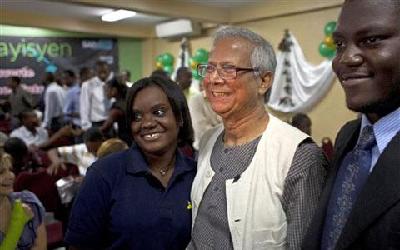
This is the VOA Special English Economics Report.
Modern microfinance started with economist Muhammad Yunus. In the 1970s, he started what became the Grameen Bank in Bangladesh. He and the bank jointly won the Nobel Peace Prize in 2006 for the idea of offering small loans to the poor to fight poverty.
Last month, Mr. Yunus spoke to the New York Times newspaper about lending problems in India. In 2010, reports of harmful microlending methods and corruption shook the state of Andhra Pradesh. Mr. Yunus noted Andhra Pradesh had intensive microlending activity at the time. He said things got out of control.
We spoke to Ghiyath Nakshbendi about changes in the world of microfinance. He is an expert in international business and teaches microfinance as a business model at the Kogod School of Business at American University.
GHIYATH NAKSHBENDI: "After what we witnessed in Andhra Pradesh, then, for example, the government of India in certain states started taking steps in order to implement, in order to introduce, regulations that will guarantee that these institutions are operating under a strict system."
Some experts have raised questions about whether microlending lifts women or poor families out of poverty. David Roodman is with the Center for Global Development, a research group in Washington. He says microloans do not do a good job of fighting poverty. He says over three billion dollars went into microcredit in 2010. But many lenders failed because of bad supervision or failure to repay loans.
In one model, governments or nongovernmental organizations, NGOs, give money to microcredit operations. Interest income is often used up by costs, rather than helping other poor borrowers. But Ghiyath Nakshbendi says that model is changing.
GHIYATH NAKSHBENDI: "In the old days, when we talk about microfinance, we are talking about an operation by which the funding is coming from wealthy individuals or government, or what have you. So it is the NGO model. Then we discovered that whatever we are getting in terms of contributions, donations and what have you -- we cannot sustain the operation."
Mr. Nakshbendi says sustainability is now a main goal.
GHIYATH NAKSHBENDI: "We moved in the last five, six years to find ways and means by which make these operations sustainable. Sustainable means simply that, 'Yes, we are going to rely on donations, but in the meantime, we are going to encourage these borrowers to save some of their money.'"
Money from savings can then be used for new loans. Mr. Nakshbendi says private equity companies are looking closely at microfinance as an investment. New models are being developed to offer more than business loans.
GHIYATH NAKSHBENDI: "And now in microfinance we talk about loans to start a business. We are talking about educational loans. We are talking about construction loans. We are talking about health insurance loans and what have you."
And that's the VOA Special English Economics Report. I'm June Simms.
Grameen Bank: 孟加拉乡村银行
Microsavings could mean big gains for the world's poor
Indian state seeks limits on microfinance after reports of abuses
Nobel Laureate urges financial services for poor
(来源:VOA 编辑:崔旭燕)
